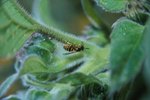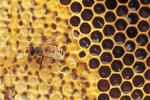Bees are social creatures, fully dependent upon their hive mates for sustenance and survival. There are times in normal bee life when workers, queens or drones find themselves trying to survive outside the hive.
Loners Lose Lives
How long a lone bee lives outside the hive depends upon its circumstances. Drones get routinely kicked out of the hive each autumn after mating is complete for the season. Cool temperatures and no honey to sustain them cause the drones to drop dead within hours of eviction, as they do not collect honey or pollen. A worker bee can last longer by using nectar in her honey stomach and replenishing it as she moves from flower to flower. If a bee gets trapped in the house with no access to nectar, she can fly for 40 minutes providing she has a full honey stomach. How long she'll survive after she runs out of nectar depends on whether she continues flying to find her way out or sitting still. You can improve her odds by offering a lost bee a homemade nectar from 1 part sugar to 1 part water to give her the strength to return to her hive.
Moving On
In a prolific bee hive, the queen may run out of room to lay new eggs. If there is no interference by a beekeeper, half of the bees will leave with the old queen in a swarm to start a new colony. Remaining workers take care of a newly hatched queen who will take over the old queen's egg-laying duties. Swarmers rest on a tree limb while scout bees seek a suitable spot for a new hive. The process may take anywhere from a few hours to a few days with the bees living without a hive until they find their new home.
Gone for the Winter
At the end of the summer season, newly hatched queens leave the hive and mate in flight with more than a dozen drones. She collects all the sperm she'll need for a lifetime of egg laying before burrowing down into leaf litter, below logs or other sheltered areas where she can spend the winter in dormancy. When temperatures rise above 57 degrees Fahrenheit in the springtime, she'll emerge and find a suitable location to begin a new hive.
Other bees in the hive are unable to make it through the winter without the concentrated support of their peers and sufficient protection from the elements. As temperatures dip below 57 degrees, bees cluster together for warmth, feeding on honey throughout the winter. A hive with enough honey to last throughout the winter can live through temperatures as low as -30 degrees.
Writer Bio
Indulging her passion for vacation vagary through the written word on a full-time basis since 2010, travel funster Jodi Thornton-O'Connell guides readers to the unexpected, quirky, and awe-inspiring.




